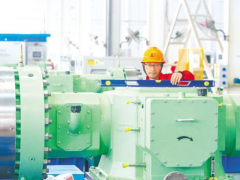印度本周提出一項(xiàng)20億美元的補(bǔ)貼計(jì)劃,以推動(dòng)國(guó)內(nèi)氫燃料的發(fā)展
印度希望以10%的成本激勵(lì)來(lái)激勵(lì)清潔氫氣生產(chǎn)商
印度政府的目標(biāo)是到2030年前非碳?xì)浠衔锶剂险计溲b機(jī)容量的50%,并在2070年前實(shí)現(xiàn)凈零排放目標(biāo)
據(jù)油價(jià)網(wǎng)2023年4月9日新德里報(bào)道,印度本周提出了一項(xiàng)20億美元的補(bǔ)貼計(jì)劃,以推動(dòng)國(guó)內(nèi)氫燃料的發(fā)展,全球氫燃料的未來(lái)看起來(lái)更加光明。挪威著名能源研究和商業(yè)情報(bào)公司挪威雷斯塔能源公司(Rystad)預(yù)計(jì),到2035年前,全球氫氣管道將增長(zhǎng)700%。如果不增加氫氣運(yùn)輸基礎(chǔ)設(shè)施,大多數(shù)氫氣項(xiàng)目仍將面臨一場(chǎng)艱苦的戰(zhàn)斗。印度政府正在實(shí)施一項(xiàng)20億美元的補(bǔ)貼計(jì)劃,以支持和激勵(lì)綠色氫氣燃料生產(chǎn)商。作為這個(gè)計(jì)劃的一部分,各方將通過(guò)競(jìng)爭(zhēng)性招標(biāo)程序獲得成本的10%激勵(lì)。激勵(lì)措施將每年逐步減少,招標(biāo)計(jì)劃將向已經(jīng)生產(chǎn)氫氣和氨氣或擁有可再生能源工廠的公司開(kāi)放。印度政府預(yù)計(jì)將頒發(fā)大約1300億盧比用于生產(chǎn)綠色氫氣,其余的財(cái)政激勵(lì)將用于支持電解槽的制造。印度生產(chǎn)綠色氫氣的總成本預(yù)計(jì)約為每公斤300盧比(約合3.7美元),他們希望在未來(lái)3年內(nèi)生產(chǎn)360萬(wàn)噸綠色氫氣。
印度政府的目標(biāo)是到2030年前非碳?xì)浠衔锶剂险计溲b機(jī)容量的50%,并在2070年前實(shí)現(xiàn)凈零排放目標(biāo)。這個(gè)競(jìng)標(biāo)計(jì)劃預(yù)計(jì)將吸引一長(zhǎng)串印度公司的興趣。印度政府還計(jì)劃以每千瓦4440盧比(54美元)的激勵(lì)措施支持電解槽的制造,他們希望在5年內(nèi)支持每年大約3000兆瓦的電解槽產(chǎn)能。
凱捷研究院的一份報(bào)告顯示,62%的全球重工業(yè)公司正在考慮用低碳?xì)錃鈦?lái)取代碳密集型系統(tǒng)。能源和公用事業(yè)(E&U)公司預(yù)計(jì),到2050年前,低碳?xì)錃鈱⒄伎偰茉聪牡?8%。報(bào)告強(qiáng)調(diào)說(shuō),需要在整個(gè)氫氣價(jià)值鏈上釋放投資,特別是開(kāi)發(fā)氫氣基礎(chǔ)設(shè)施、具有成本效益的電解槽和燃料電池。報(bào)告還指出,到2050年前,低碳?xì)錃饪梢詽M足高達(dá)55%的氫氣混合總量。平均而言,到2030年前,E&U公司每年總收入的0.4%將用于低碳?xì)錃猓貏e是氫能的運(yùn)輸和分配、生產(chǎn)和研發(fā)。企業(yè)必須在整個(gè)價(jià)值鏈中建立正確的協(xié)作,確保其承接,開(kāi)發(fā)氫氣能力中心,并利用模擬、數(shù)字孿生和可追溯解決方案等技術(shù),成功擴(kuò)展其低碳?xì)錃庥?jì)劃。
在需求方面,大部分的需求預(yù)計(jì)將來(lái)自傳統(tǒng)的氫氣用戶,如原油煉制工業(yè)、化工和化肥:94%的原油煉制公司預(yù)計(jì)到2030年前將對(duì)他們的行業(yè)產(chǎn)生重大影響;同樣,83%的化學(xué)品和化肥公司預(yù)計(jì)會(huì)有類似的效果。凱捷研究院調(diào)查的參與者表示,他們預(yù)計(jì)重型運(yùn)輸、航空和海事等新應(yīng)用將增加對(duì)氫氣的需求。然而,所有調(diào)查參與者仍然認(rèn)為,在上述領(lǐng)域,特別是在生產(chǎn)、工程和基礎(chǔ)設(shè)施領(lǐng)域,氫氣應(yīng)用仍存在主要制約因素。Rystad在一份新報(bào)告中也提到了這些問(wèn)題。Rystad表示,由于未來(lái)幾年氫氣管道在中短程運(yùn)輸氫氣方面將比容器“好得多”,重點(diǎn)應(yīng)放在擴(kuò)大全球綠色氫氣管道基礎(chǔ)設(shè)施上。
未來(lái)是光明的,Rystad預(yù)測(cè),未來(lái)12年全球氫氣管道項(xiàng)目預(yù)計(jì)將增加700%。目前,4300公里的氫氣管道中有90%在歐洲和北美。在全球范圍內(nèi),紙面上和開(kāi)發(fā)初期計(jì)劃的氫氣管道項(xiàng)目約有91個(gè),到2035年左右將有3.03萬(wàn)公里氫氣管道投入使用。
李峻 編譯自 油價(jià)網(wǎng)
原文如下:
India Looks To Kickstart Hydrogen Production With $2 Billion Plan
· India, this week, presented a $2 billion subsidy scheme to push domestic hydrogen fuels.
· India looks to incentivize producers of clean hydrogen with a 10% cost incentive.
· The Indian government aims to have 50% of its installed power generation capacity by 2030 from non-hydrocarbon fuels and reach its net-zero goals by 2070.
The future of global hydrogen is looking brighter as India, this week, presented a $2 billion subsidy scheme to push domestic hydrogen fuels, and Rystad Energy foresees a 700% growth of global hydrogen pipelines by 2035. Without an increase in hydrogen transport infrastructure, most projects will still face an uphill battle. The Indian government is implementing a $2 billion scheme to support green hydrogen fuel producers. As part of the plan, parties will receive a 10% incentive on their costs, awarded through a competitive bidding process. The incentives will taper down annually, and the bidding scheme will be open to companies already producing hydrogen and ammonia or having renewable energy plants. The government expects to award around 130 billion rupees for the production of green hydrogen and the rest of the financial incentive will be used to support the manufacturing of electrolyzers. India's overall cost of producing green hydrogen is expected to be around 300 rupees per kilo (U.S.$ 3.70), and they hope to produce 3.6 million tons of green hydrogen in the next three years.
The Indian government aims to have 50% of its installed power generation capacity by 2030 from non-hydrocarbon fuels and reach its net-zero goals by 2070. The bidding scheme is expected to attract interest from a long list of Indian companies. The government also plans to support the manufacturing of electrolyzers with an incentive fixed at 4,440 rupees (U.S. $54) per kilowatt, and they hope to support around 3000MW of annual electrolyzer capacity for five years.
A report by CapGemini Research Institute shows that 62% of global heavy industry companies are looking at low-carbon hydrogen to replace carbon-intensive systems. Energy and Utilities (E&U) companies expect low-carbon hydrogen to meet 18% of total energy consumption by 2050. The report highlights the need to unlock investment across the hydrogen value chain, notably to develop hydrogen infrastructure, cost-effective electrolyzers, and fuel cells. The report indicates that low-carbon hydrogen could meet up to 55% of hydrogen mix totals by 2050. On average, 0.4% of total annual revenue is earmarked for low-carbon hydrogen by E&U organizations by 2030, in particular, for hydrogen energy transport and distribution, production, and R&D. Organizations must establish the right collaboration throughout the value chain, secure their offtake, develop hydrogen-competence centers, and harness technologies like simulations, digital twins, and traceability solutions to scale their low-carbon hydrogen initiatives successfully.
On the demand side of things, the lion's share of demand is expected from traditional hydrogen users such as the petroleum refining industry, chemicals, and fertilizers: 94% of petroleum refining organizations anticipate a significant impact on their industry by 2030; similarly, 83% of chemicals and fertilizer companies expect a comparable effect. The participants in the Capgemini survey indicated that they expect that new applications like heavy-duty transportation, aviation, and maritime will increase demand for hydrogen. All participants, however, still see major constraints for hydrogen applications in the abovementioned sectors, especially in production, engineering, and infrastructure. These indicators are also being addressed in a new report by Norwegian consultancy Rystad Energy, although the consultancy is more optimistic about these bottlenecks. Rystad stated that due to the fact that hydrogen pipelines will be “far better” than vessels at moving hydrogen over short- and medium-range distances in the years ahead, the emphasis should be put on expanding global green hydrogen pipeline infrastructure.
The future looks bright, as Rystad foresees that global hydrogen pipeline projects are expected to increase by 700% over the next 12 years. At present, 90% of the 4300 km of pipelines are in Europe and North America. Worldwide, there are about 91 planned pipeline projects on paper and in the early phases of development, with 30,300 km set to go online by around 2035.
免責(zé)聲明:本網(wǎng)轉(zhuǎn)載自其它媒體的文章及圖片,目的在于弘揚(yáng)石化精神,傳遞更多石化信息,宣傳國(guó)家石化產(chǎn)業(yè)政策,展示國(guó)家石化產(chǎn)業(yè)形象,參與國(guó)際石化產(chǎn)業(yè)輿論競(jìng)爭(zhēng),提高國(guó)際石化產(chǎn)業(yè)話語(yǔ)權(quán),并不代表本網(wǎng)贊同其觀點(diǎn)和對(duì)其真實(shí)性負(fù)責(zé),在此我們謹(jǐn)向原作者和原媒體致以崇高敬意。如果您認(rèn)為本站文章及圖片侵犯了您的版權(quán),請(qǐng)與我們聯(lián)系,我們將第一時(shí)間刪除。







